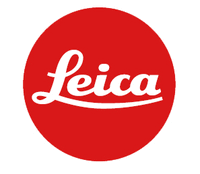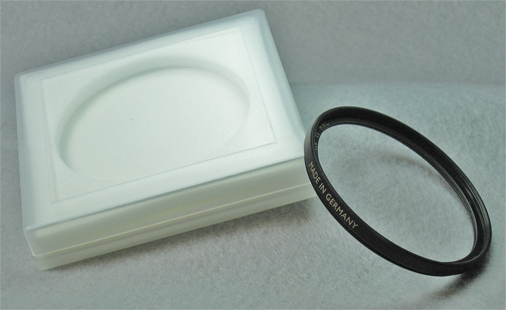Index Page
![]() News
News ![]() Products
Products ![]() Pricing
Pricing ![]() Distribution
Distribution ![]() Notes & Interesting Articles
Notes & Interesting Articles
Binoculars
![]() Telescopes
Telescopes
![]() Cameras
Cameras ![]() Accessories
Accessories ![]() Warranty / Service & Repair
Warranty / Service & Repair

 Leica APO-TELEVID Field Telescope UV & Protective Filter
Leica APO-TELEVID Field Telescope UV & Protective Filter

Above: Multicoated UV Haze filter made to C7 specifications for our TELEVID customers (03,247 bytes).
Click on image to see enlarged view (264,406 bytes).
The circular and linear Polarizing filters are among the most valuable accessories that may be installed onto a binocular or spotting telescope since these can greatly reduce the glare or light reflected off of water or glass, from leaves, feathers, and from other non metallic surfaces. These bring comfort and more clarity to the observing experience. But there is another filter offered by Company Seven that offers peace of mind, and this is the 'UV' (ultraviolet) filter, sometimes marketed as a haze filter.
Daylight as we observe it is made up of red, green and blue light in that portion of the spectrum which the human eye can detect, this region is known as the visible spectrum. This occupies wavelengths from approximately the deep violet in the shorter wavelengths just below 400 nanometers (nm) up to the longer wavelengths of the deep red at about 700 nm. The human eye evolved to help us survive in a day lit world dominated by the green of vegetation, as such it has developed a photopic (light-adapted) sensitivity that spans from about 400 nm to 700nm, peaking at about 555 nm. Since the eye is so sensitive here this is why some emergency vehicles are painted "slime lime" so that they are very obvious for example. And our scotopic (dark-adapted) sensitivity ranges from 400 nm up to 620 nm losing some red efficiency peaking at 510 nm. This is why astronomers and military working at night prefer to work in dim red light that does not cause the Iris of the eye to constrict and lose light gathering efficiency.

Above: Visible portion of the electromagnetic spectrum with bordering regions (20,129 bytes).
Bundled with the daylight are light rays in the ultraviolet. At and near sea level in most areas the UV has been attenuated by the atmosphere, and so it is not as intense as it can be at higher altitudes. However, in Ozone depleted regions including Antarctica and throughout the southern latitudes of South America the UV can be so intense that it promotes adverse health effects and casts a blue tone onto objects in the distance. In outdoor daytime environments the UV from the blue sky can be picked up by CCD sensors of digital cameras and by film, appearing as a subtle bluish cast across the image. The colorless and transparent UV filter was developed to block the portion of the spectrum where this effect is most notable. Since the UV filters appear transparent to the human eye these filters are also a good choice as a protective sacrificial optical window over camera lenses and spotting telescopes. Given the range of outdoor environments in which our lenses can be employed, Company Seven recommends the use of UV filters for both imaging and for protective properties.
There are a number of companies making UV filters, and their effects vary subtly from one to another brand. Company Seven has selected to offer UV filters made by Leica, and those made by a third party in Germany. The choice of these filters was based on several criteria:
- homogeneity (purity) of the raw glass used to make the filter
- absence of striae (ripple) in the raw glass used to make the filter
- consistent quality of smoothness of the surface
- parallelism of the two surfaces
- spectral transmission by bandwidth and percentage
- anti-reflection coatings properties and durability
We selected to offer UV filters that have very little perceptible adverse impact in what is seen. These are among the best performing filters at transmitting light, typically better than 96%, across this visible spectrum. And the effect on photography is modest since their impact is between 350 nm to 400 nm and is typically a one-half (½) Stop or so impact on exposure. Note we do offer some more intense UV filters that have as much as a five (5) Stop factor in the 350 nm to 400 nm spectrum!
PROTECT YOUR INVESTMENT! The UV filter may be left threaded onto the telescope for uses day or night. And having a filter in place not only can protect the front lens of your TELEVID but it reinforces the filter threading ahead of the lens protecting this from being bent if moderately impacted.
The problems we experienced with the first production models of the Leica APO-TELEVID 82 prompted us to recall an experience we had in the 1990's with a customer in Annapolis, Maryland:
-
This customer purchased from Company Seven a new Leica APO-TELEVID 77 which at that time was accompanied by Leica's 'Passport Protection Plan', a lifetime no-fault warranty. Some weeks later he returned to Company Seven with the telescope claiming there had been some defect of the front lens coatings and because of this the telescope was no longer useable. We inspected the objective lens and found it was covered with spots of some hard contaminant, a spray that we could not dissolve. It was obvious to us that something had been sprayed onto the lens but the customer insisted otherwise. Regardless, the telescope was under warranty and we simply returned it to Leica, and they in turn provided a replacement APO-TELEVID 77 that we delivered to the customer.
Some months later that customer again visited Company Seven. We became engaged in a casual conversation where the person admitted he had been using the spotting telescopes to look at women on the boats in the harbor. His wife had caught him doing so and broke his first spotting telescope (a Fuji 80 ED bought from Company Seven), and then she sabotaged his APO-TELEVID 77 with a spray; he initially lied to us about the sabotage worrying that we might not cover the telescope under warranty if he had been honest about this!
Had his Leica spotting scope had a protective UV filter installed then Leica would not have had to give this man a free replacement $2,000+ telescope.
Back to Leica products index page
Contents Copyright 2009 Company Seven - All Rights Reserved

